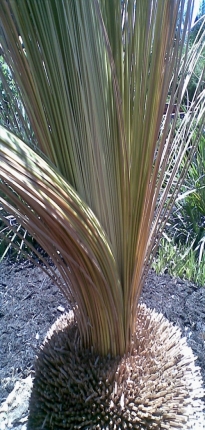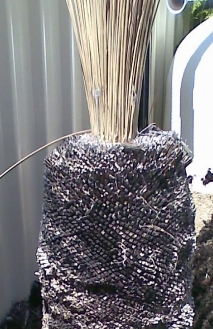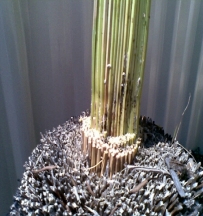Grass Tree Health Care
Transplanting a grass tree involves a specialised process of tree preparation, extraction from the ground and ongoing care. When you follow the replants transplant instructions and acknowledge our design and site considerations the process is painless and results in healthy vibrant grass trees. As a guide you should expect to see the following changes to your grass tree over the next 24 months.
- First 6mnths Rapid root growth with some browning of foliage tips. Outer layer of foliage can also brown but don't be concerned.
- 6 to 12mths New root system becomes established as roots grow downwards following moisture from regular deep saturation watering. Lots of new yellow foliage shoots growing from centre of tree begin to appear and turn to a bright green as they become exposed to sunlight.
- 12 to 24mths New foliage is predominant as older foliage has begun forming a dry skirt around trunk. Root system is well developed however deep watering is still required to carry tree through periods of high evaporation until roots have become more established.
- 24mths ON Grass tree has developed root system and is now self reliant in finding it's own water to survive. The brown skirt of spent foliage may be trimmed if desired to reveal the black trunk once again.
Below is a list of problem insects and fungus and recommended action you can take if your grass tree becomes affected.
Mildew Found in the grass head of grass trees which are under stress after transplant. Mildew is a fungus which thrives in a humid environment of tightly bunched foliage. Wettable sulphur or Mancozeb Plus will treat the problem. Removal of some foliage to increase air circulation is also helpful.

Scale Scales are sapsuckers and also cause a fungus, known as ‘sooty mould'. Sooty mould grows on the excretions of the scales. Spray pyrethrin onto the infected foliage. Neem oil will also help control scale.
Mealybugs
Like scales, Mealybugs are sapsucking insects. Mealybugs are small insects usually found in protected areas of the foliage. Spray white oil onto affected foliage but not during hot weather.

Rust This is a fungus which is usually associated with humidity within the foliage. A fugicide such as Mancozeb which contains wettable sulphure will keep rust in check after a few applications. Preventative measures are to water in the mornings and minimise any spray which may contact the foliage particularly near the crown.
Slaters Keep mulch 100mm from base of trunk and remove any decomposing leaf matter from foliage.
Signs of Grass Tree Stress
There are four quick checks you can do if your grass tree is looking stressed or sick.
1. Is the new foliage in the centre of the tree healthy? If it is the brown foliage may just be a response to the hot weather. If not then the tree is under stress so apply apply Seasol or Ecovital over the foliage and around the base of the tree once a month. This is recommended for healthy trees also.
2. Is the tree getting enough water. Water 2 to 3 times per week over hot months with 50L per watering. Water 1 to 2 times per week in cooler months. During times of high rainfall you do not need to water.
3. Is the tree getting too much water. Check the mulch is not piled up around the base of the trunk. Check the base of the tree is not waterlogged eg the black part of the trunk where it touches the ground is dry and firm, not soft. If soft clear away the mulch and even the sand to expose the black trunk which may be in the ground
4. Is the foliage under attack from powdery mildew or mealy bugs. Check low down on the foliage, is it coated with a powder substance or little grey white bugs. If so spray with Mancozeb or White oil.
Water logged roots
Transplanting grass trees into clay soils with insufficient drainage can lead to a water logged root system. The grass tree typically looks healthy for many months with green foliage however new growth is very limited. Limiting the water delivery or improving the drainage of the soil, so it is only moist not saturated, can help overcome this problem. However if new shoots are not fresh in appearance and can be easily pulled out from the crown, the tree does need replacing.
Water logging also occurs when a grass tree is installed too deep in the ground ( lower than the existing soil line ) and the black part of the trunk becomes soft. This can be remedied by removing dirt from the base of the tree until all the black trunk is exposed or the roots are only a few inches below the soil.
Another way grass trees are waterlogged is when mulch is piled around the base of the tree and holds excess moisture against the trunk. This will also soften the trunk and make it vulnerable to insect and pathogen attack.
Watering systems which spray directly onto the trunk are to avoided for the same reasons.
Dehydration
Signs of plant dehydration include browning of the foliage from the tips and poor foliage shape. Increasing the water delivery and a dose of kelp powder typically improves the plant health. A small amount of browning on foliage tips during periods of hot weather is natural so don't be alarmed.
Below are case studies of customers trees which were showing signs of stress.

Some transplanted grass trees will show signs of transplant stress usually coinciding with increasing temperatures as we move into summer.
Foliage tips and the outer layer of foliage will brown making the grass tree look quite sick especially when other grass trees planted at the same time remain green and in good shape.
Naturally you will think this tree is not well, but more often than not on closer examination of the new foliage growth you will find the tree is healthy. The new grass shoots should look crisp and vibrant. A small amount of discolouration on the tips is ok.
By maintaining our suggested twice weekly deep watering and adding an additional watering during sustained hot weather these trees normally bounce back. As an added remedy apply Seasol or similar seaweed tonic to the tree each month to encourage root growth and help improve the trees resiliance to insect infestation.



The above grass tree has set back giving the appearance of a dead tree from a distance. On closer inspection there is an abundance of new foliage growth indicating the tree is healthy and will bounce back with a a new flush of growth over the coming months.


The above grass tree had mulch piled thickly against the base of the trunk and the tree was beginning to rot. The outer foliage had browned, however after prunung the dead foliage we found the central foliage was still reasonably healthy although it was infested with Mealy bugs. A few applications of Confidore or White oil will remove the Mealy bugs and now the mulch has been pushed back from the trunk the tree has a chance to dry out and survive.

The inner core of the above grass tree has begun to rot causing the new foliage to dry out and discolour. The foliage would pull out quite easily from the centre and have a smell similar to rotting fruit. The head of the tree would also be full of small grubs which look like maggots. The tree cannot be saved and should be removed from the garden.
Remedial action for advanced insect infestation
Many infestations can be overcome by burning the foliage of the grass tree. Burning will kill problem insects and their larvae.
In large multi trunk grass trees which insects such as borers have infested it is appropriate action to remove the infected trunk to stop the infestation attacking other parts of the grass tree. A chain saw is used to remove the trunk then the cut is sealed with a sterile sealant.

